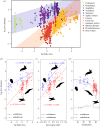Universal metabolic constraints shape the evolutionary ecology of diving in animals
- PMID: 32453989
- PMCID: PMC7287373
- DOI: 10.1098/rspb.2020.0488
Universal metabolic constraints shape the evolutionary ecology of diving in animals
Abstract
Diving as a lifestyle has evolved on multiple occasions when air-breathing terrestrial animals invaded the aquatic realm, and diving performance shapes the ecology and behaviour of all air-breathing aquatic taxa, from small insects to great whales. Using the largest dataset yet assembled, we show that maximum dive duration increases predictably with body mass in both ectotherms and endotherms. Compared to endotherms, ectotherms can remain submerged for longer, but the mass scaling relationship for dive duration is much steeper in endotherms than in ectotherms. These differences in diving allometry can be fully explained by inherent differences between the two groups in their metabolic rate and how metabolism scales with body mass and temperature. Therefore, we suggest that similar constraints on oxygen storage and usage have shaped the evolutionary ecology of diving in all air-breathing animals, irrespective of their evolutionary history and metabolic mode. The steeper scaling relationship between body mass and dive duration in endotherms not only helps explain why the largest extant vertebrate divers are endothermic rather than ectothermic, but also fits well with the emerging consensus that large extinct tetrapod divers (e.g. plesiosaurs, ichthyosaurs and mosasaurs) were endothermic.
Keywords: allometry; ectothermy; endothermy; evolutionary physiology; palaeophysiology; scaling.
Conflict of interest statement
The authors declare no competing interests.
Figures


Similar articles
-
Common metabolic constraints on dive duration in endothermic and ectothermic vertebrates.PeerJ. 2016 Oct 12;4:e2569. doi: 10.7717/peerj.2569. eCollection 2016. PeerJ. 2016. PMID: 27761347 Free PMC article.
-
Allometry of diving capacities: ectothermy vs. endothermy.J Evol Biol. 2008 Jan;21(1):324-329. doi: 10.1111/j.1420-9101.2007.01438.x. Epub 2007 Nov 14. J Evol Biol. 2008. PMID: 18005017
-
The comparative biology of diving in two genera of European Dytiscidae (Coleoptera).J Evol Biol. 2012 Feb;25(2):329-41. doi: 10.1111/j.1420-9101.2011.02423.x. Epub 2011 Dec 8. J Evol Biol. 2012. PMID: 22151892
-
The role of myoglobin in the evolution of mammalian diving capacity - The August Krogh principle applied in molecular and evolutionary physiology.Comp Biochem Physiol A Mol Integr Physiol. 2021 Feb;252:110843. doi: 10.1016/j.cbpa.2020.110843. Epub 2020 Nov 10. Comp Biochem Physiol A Mol Integr Physiol. 2021. PMID: 33181325 Review.
-
Diving in hot water: a meta-analytic review of how diving vertebrate ectotherms will fare in a warmer world.J Exp Biol. 2021 Feb 24;224(Pt Suppl 1):jeb228213. doi: 10.1242/jeb.228213. J Exp Biol. 2021. PMID: 33627460 Review.
Cited by
-
Diving into a dead-end: asymmetric evolution of diving drives diversity and disparity shifts in waterbirds.Proc Biol Sci. 2022 Dec 21;289(1989):20222056. doi: 10.1098/rspb.2022.2056. Epub 2022 Dec 14. Proc Biol Sci. 2022. PMID: 36515120 Free PMC article.
-
Osmoregulatory ability predicts geographical range size in marine amniotes.Proc Biol Sci. 2021 Apr 14;288(1948):20203191. doi: 10.1098/rspb.2020.3191. Epub 2021 Apr 7. Proc Biol Sci. 2021. PMID: 33823670 Free PMC article.
-
The ecological importance of the accuracy of environmental temperature measurements.Biol Lett. 2022 Aug;18(8):20220263. doi: 10.1098/rsbl.2022.0263. Epub 2022 Aug 10. Biol Lett. 2022. PMID: 35946234 Free PMC article.
-
Plasticity matches phenotype to local conditions despite genetic homogeneity across 13 snake populations.Proc Biol Sci. 2021 Jan 27;288(1943):20202916. doi: 10.1098/rspb.2020.2916. Epub 2021 Jan 27. Proc Biol Sci. 2021. PMID: 33499786 Free PMC article.
-
A heavyweight early whale pushes the boundaries of vertebrate morphology.Nature. 2023 Aug;620(7975):824-829. doi: 10.1038/s41586-023-06381-1. Epub 2023 Aug 2. Nature. 2023. PMID: 37532931
References
-
- Schreer JF, Kovacs KM. 1997. Allometry of diving capacity in air-breathing vertebrates. Can. J. Zool. 75, 339–358. (10.1139/z97-044) - DOI
-
- Mill PJ. 1974. Respiration: aquatic insects. In Physiology of the Insecta (ed. Rockstein M.), pp. 403–467. New York, NY: Academic Press.
Publication types
MeSH terms
Substances
Associated data
LinkOut - more resources
Full Text Sources
Other Literature Sources

